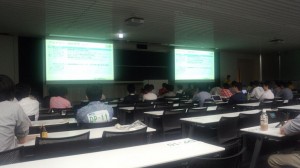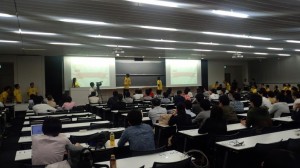Waseda University and International Information Science Foundation together with many organizations, supporters and sponsors successfully hold The 2014 ACM-ICPC Asia Tokyo Regional Contest (Director: Assoc. Prof. Washizaki) on Oct 18-20 in National Olympics Memorial Youth Center, Access and Local Information. Thank you for participation and supports!
カテゴリー別アーカイブ: 未分類
Assoc. Prof. Washizaki gave a talk on Generalized Software Reliability Model at NII Shonan Meeting on Computational Intelligence for Software Engineering.
Hironori Washizaki, “Predicting Release Time Based on Generalized Software Reliability Model”, NII Shonan Meeting on Computational Intelligence for Software Engineering, Shonan Village, Oct 21, 2014.
One team from our group competed at ET Robocon 2014.
On Oct 11-12, JASA together with Waseda University Global Software Engineering Laboratory (Head: Assoc. Prof. Washizaki) held Tokyo Preliminary Round, ET Software Design Robot Contest 2014 (shortly ET Robocon 2014) at 2F Building 63, Waseda University.
On the first day, one team from our group competed in the Primary Category. Team members were M1 Koji, Yusuke, B4 Youhei, Kazuki, Leou, Toru and B3 Kento. Unfortunately they could not move into the Championship Round; however they did well planning, design, and construction of embedded systems and software. Especially, their second run (out of two) was beautiful and perfect! See the following video on YouTube. Good Job! It is expected that they will make use of the experience to their future learning, research, and career.
Security and Privacy Behavior Definition for Behavior Driven Development, accepted as short paper at PROFES 2014 (CORE Rank B).
Takao Okubo, Yoshio Kakizaki, Yoshinori Kobashi, Hironori Washizaki, Shinpei Ogata, Haruhiko Kaiya and Nobukazu Yoshioka, “Security and Privacy Behavior Definition for Behavior Driven Development,” Proceedings of the 15th International Conference of Product Focused Software Development and Process Improvement (Profes 2014), Short Paper, Helsinki, Finland, 10-12 December 2014. (to appear)
Comparative Study on Programmable Robots as Programming Educational Tools, accepted at ACE 2015 (CORE Rank Australasian, originally Rank B at ERA2010).
Shohei Yamazaki, Kazunori Sakamoto, Kiyoshi Honda, Hironori Washizaki, Yoshiaki Fukazawa, “Comparative Study on Programmable Robots as Programming Educational Tools,” Proceedings of the 17th Australasian Computing Education Conference (ACE 2015), Sydney, Australia Tuesday 27th – Friday 30th January 2015. (to appear)
Computational Thinking skills are basic and important to manipulate computers. Currently, several systems exist to provide a effective way to learn programming that use computers, smartphones, tablets, or programmable robots. Although studies have reported improved programming skills and motivation to learn programming using an on-screen application or a programmable robot, the benefits of these tools have not been directly compared. To resolve this issue, especially with regard to motivation to learn programming and impression of programming, we conducted a large-scale comparative experiment involving 236 middle and high school students to evaluate the effects of a game-based educational application and programmable robots on learning programming. We then compared the effects of a game-based educational application with and without programmable robots on learning programming. We found that employing programmable robots on learning programming did not always have an improvement on students.
FOSE2014にて2件の共著: 重要意思決定キャンバス、OSSの不具合修正曲線に基づく残存未修正不具合数予測
横田真人、雨谷幸郎、井出昌浩、鷲崎弘宜、”システム企画における最適な意思決定のための重要意思決定キャンバスの提案”、ショートペーパ、日本ソフトウェア科学会 第21回 ソフトウェア工学の基礎ワークショップ FOSE 2014 in 霧島、霧島国際ホテル、2014年12月11日(木) – 13日(土)
藤野啓輔、伊原彰紀、本田澄、鷲崎弘宜、松本健一、”OSSの不具合修正曲線に基づく残存未修正不具合数の予測の試み”、ショートペーパ、日本ソフトウェア科学会 第21回 ソフトウェア工学の基礎ワークショップ FOSE 2014 in 霧島、霧島国際ホテル、2014年12月11日(木) – 13日(土)
Continuous Product-Focused Project Monitoring with Trend Patterns and GQM, accepted at QuASoC 2014.
Hidenori Nakai, Kiyoshi Honda, Hironori Washizaki, Yoshiaki Fukazawa, Ken Asoh, Kaz Takahashi, Kentarou Ogawa, Maki Mori, Takashi Hino, Yosuke Hayakawa, Yasuyuki Tanaka, Shinichi Yamada, Daisuke Miyazaki, “Continuous Product-Focused Project Monitoring with Trend Patterns and GQM,” Proceedings of the 2nd International Workshop on Quantitative Approaches to Software Quality, pp.XX-YY, in conjunction with the 21st Asia-Pacific Software Engineering Conference (APSEC 2014), Jeju, Korea, December 1, 2014. (to appear)
It is important for project stakeholders to identify a state of projects and quality of products. Although metrics are useful for identifying them, it is difficult for project stakeholders to select appropriate metrics and determine the purpose of measuring metrics. We propose an approach which defines the measured metrics by GQM method, and supports identifying tendency of projects and products based on Trend Pattern. Additionally, we implement a tool as Jenkins Plugin which visualizes an evaluation results based on GQM method. We perform an experiment with OSS and industrial case study with two software development projects. In our experiment, we can identify the problem and project tendency. In our industrial case study, we can also identify the problem that project contains. As our future work, we adopt our approach and GQM Plugin to software de-velopment project continuously to assess the effectiveness of them in long term.
Joint Summer Seminar Camp was successfully over!
Do open source software projects conduct tests enough? , accepted as short paper at Profes 2014 (CORE Rank B).
Ryohei Takasawa, Kazunori Sakamoto, Akinori Ihara, Hironori Washizaki, Yoshiaki Fukazawa, “Do open source software projects conduct tests enough?,” Proceedings of the 15th International Conference of Product Focused Software Development and Process Improvement (Profes 2014), Short Paper, Helsinki, Finland, 10-12 December 2014. (to appear)
Do open source software projects provide and maintain tests? What metrics are correlated with the test success? This paper answers these questions by executing tests of 452 open source software projects in GitHub and measuring 13 metrics from 77 projects. Only 117 projects passed all test cases. Additionally, the results are correlated with the comment density, public documented API density, and test coverage.
Identifying rationales of strategies by stakeholder relationship analysis to refine and maintain GQM+Strategies models, accepted as full paper at Profes 2014 (CORE Rank B).
Takanobu Kobori, Hironori Washizaki, Yoshiaki Fukazawa, Daisuke Hirabayashi, Katsutoshi Shintani, Yasuko Okazaki, Yasuhiro Kikushima, “Identifying rationales of strategies by stakeholder relationship analysis to refine and maintain GQM+Strategies models,” Proceedings of the 15th International Conference of Product Focused Software Development and Process Improvement (Profes 2014), Helsinki, Finland, 10-12 December 2014. (to appear)
To achieve overall business goals, GQM+Strategies is an approach that aligns the business goals at each level of an organization to strategies and assesses the achievement of goals. Strategies derived from business goals are based on rationales (context factors and assumptions). Because extracting all rationales is an important process in the GQM+Strategies approach, we propose Context-Assumption-Matrix (CAM), which refines the GQM+Strategies model by extracting rationales based on the analysis of the relationships between stakeholders, and the Context Assumption (C/A) definition template to unify the expressive style of contexts and assumptions. To demonstrate the effectiveness of CAM, we conducted an experiment involving 43 students majoring in information sciences at Shimane University in Japan. GQM+Strategies with CAM can extract rationales more efficiently and exhaustively than GQM+Strategies alone. Moreover, when the management policy or the business environment changes, GQM+Strategies with CAM can analyze the rationales and the GQM+Strategies grid easily.







